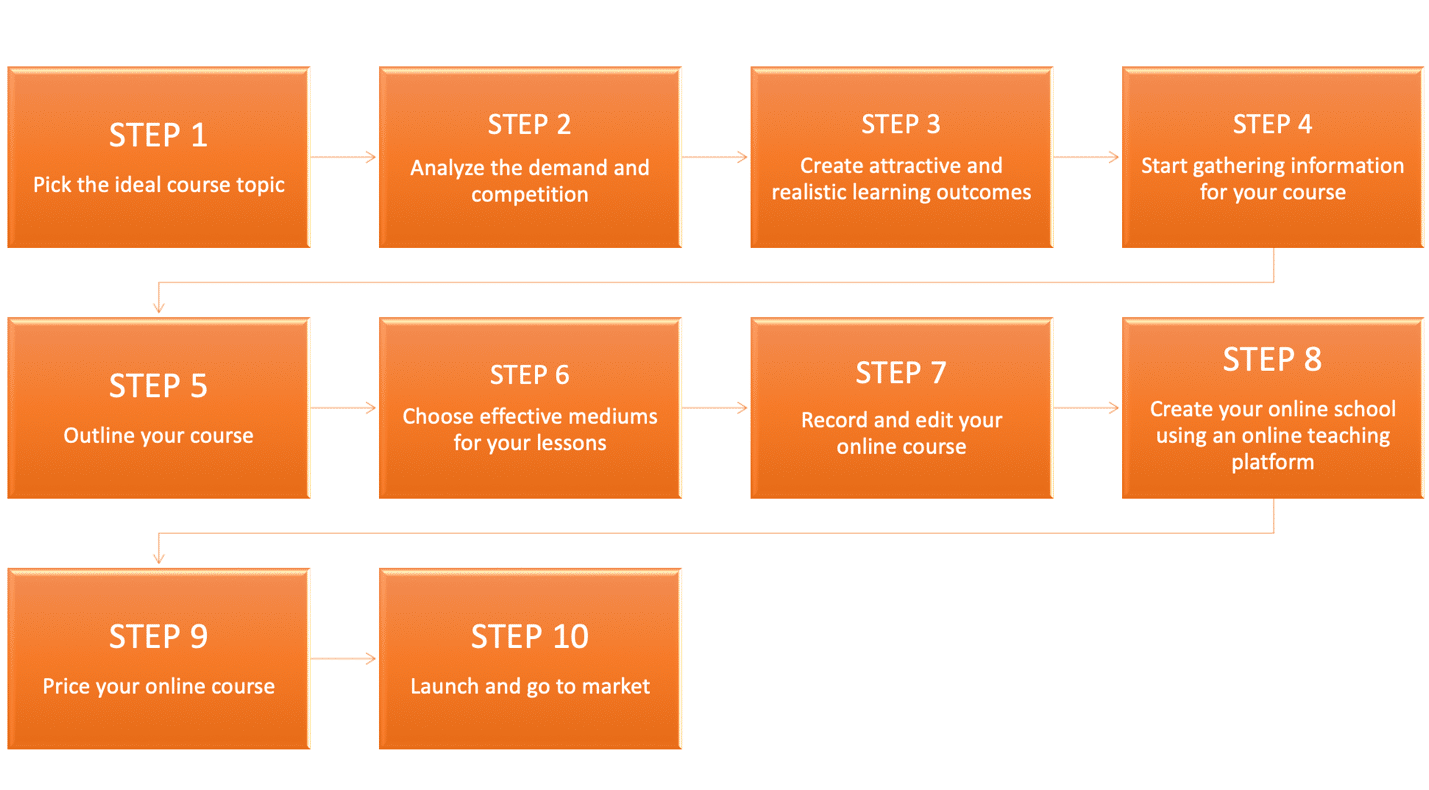Are you thinking of creating online courses and selling them to people across the globe? If you are considering it, you’ve come to the right place. In this guide, we’ll discuss the key steps to creating and selling online courses – what to do, what to avoid, and how to be efficient.
But before we dive into the how – let’s discuss the why.
Why should you build and sell online courses?
Since the recent pandemic, people have adapted to shopping and being entertained via online platforms. Similarly, they’ve also adapted to learning new skills online. This could be anything from learning a new hobby to getting fit by taking online yoga classes.
No matter what course topic they choose – the fact is that they’re choosing to spend money online in exchange for knowledge. And this is why e-learning has become such a trend.
So, we’ve established that the demand for online courses is there. But can it be as profitable as we want it to be?
Well, that all depends on how you set up your online school. For example, you choose to have multiple video monetization models, revenue streams, and price points. In that case, you will appeal to a wider audience, which will hopefully gain more revenue and profits in the long run. In the same way, if you choose an appealing course topic to teach, you’ll probably have more customers quickly. Another point to consider is using an online teaching platform that helps you build courses, market them, and manage your revenue all in one space.
So, this is what this guide is all about; teaching you how to create and sell online courses the right way. The best part? It doesn’t have to be complicated to be effective.
Let’s take a deeper look at the ten steps to create and sell online courses effectively.
How to Create and Sell Online Courses: A 10-Step Guide
Step #1: Pick the ideal course topic
The first step is to start searching for a course topic. Now, this doesn’t necessarily mean that you should choose something off the top of your head. Instead, try this method:
First, write down all the things you’re passionate about doing.
Next, match each topic to what your friends, family, or colleagues think you’re good at.
Now, take this refined list of your passions and match them to what people are searching for online.
But you may be asking yourself, “How can I know what people want to learn?”
The answer to that is simple – research! You can research each topic on online forums, social media, and blogs. People’s comments will allow you to better understand what they’re searching for and if your topic/s fits their needs.
You can also ask friends and family for their opinion. Try to get as much feedback as you can before choosing a topic.
You can choose just about any topic. Here are some examples of topics for online courses out there today:
- Fitness: Pilates, yoga, and bodybuilding.
- Business: Business management, project management, etc.
- Arts and Crafts: Embroidery, photography, music, floral arranging.
- Lifestyle: Coaching for personal or career development.
Step #2: Analyze the demand and competition for your course topic
We’ve spoken a bit about how your course topic should have some demand for it. And the first step is to do research to better understand the demand for it. But you can go a step further than that.
Learning is an active behavior, and people tend to want to learn more as time goes by. It is in our DNA. So, as a course creator, you can use this to your advantage. When trying to establish whether there’s a high demand for your online course topic – simply go out and see what others are teaching within that topic. Also, try to find out how these online courses are making their customers feel.
For example, there are hundreds of yoga instructors out there. Go to their websites and research the type of yoga they teach, how much they charge, and what their customers have to say about their learning programs. By doing this, you’ll be able to better understand how different your yoga teaching will be from theirs, how best to price your courses, and what will bring a customer to you versus another yoga instructor.
Analyzing the demand and competition for a course topic helps you gain a competitive advantage because it forces you to start thinking laterally about your business. This is key to your success.
You have to be different – or no one will be enticed by your course offer.
Step #3: Create attractive and realistic learning outcomes
Now that you have a greater understanding of where your course idea lies in terms of demand and competition – it’s time to start looking at it from your customer’s point of view.
How attractive does a course look to a potential learner? What draws them in?
Most importantly, once they complete your course – what learning outcomes can they expect to gain?
In today’s world, most people want to invest time, money, and effort into something they see value in. Gaining value allows them to feel like the time they’ve spent doing something (in this case, learning a topic online) was worth it. They want to upskill, adapt and feel more empowered.
As a result, the courses you create and sell online should always have the following:
- A clear and concise learning outcome.
- A well-defined content map and learning pathway.
- A “next steps” section.
When you provide learners with a clear vision of what their goals are before they begin a course, what the pathway is of the program, and what they should do when they complete the course, they will have good direction and feel more comfortable signing up for it.
Step #4: Start gathering information for your course
The next step is the start of the production phase. This is where you start to create your online course content. But before you begin writing up courses, you will need to start gathering the course information and laying it out methodically.
This may sound like a step you can skip – but it is a crucial one. Why? Your course must always link to your learning outcomes and overall teaching objectives.
Sometimes, writing without a clearly defined pathway can stray you from the course’s purpose, resulting in a disjointed and haphazard course for your learners. And that’s the last thing we want!
Here are a few tips for gathering information effectively:
- Start to look for all the information related to your course topic.
- Write down any notes or tips you’ve learned being an expert in this topic.
- Jot down any and all terms that should be defined or possible FAQs. Then write down the answers to these questions and definitions of these terms.
- Gather and reference any resource books or blogs you’ve used in this process.
Step #5: Outline your course
Once you have your information gathered, it’s time to take all this content and create a course outline from it.
What is a course outline?
A course outline is simply a map of your course from start to finish. Each course outline should have topics and subtopics. Here is an example of what your course outline can look like:
Online Herb Gardening Course:
- Topic 1: Introduction
- Subtopic: A quick introduction to your teacher
- Topic 2: The basics of herbs
- Subtopic: A brief history of herbs
- Subtopic: Terms you should know
- Topic 3: How to garden
- Subtopic: A practical lesson on indoor herb gardening
- Topic 4: Conclusion
- Subtopic: Test your knowledge
- Subtopic: Key takeaways
As you can see, the course outline can be quite linear and shows a general progression through the course. The idea here is to have a course outline and place your content into various topics and subtopics within the outline. This will make course creation much easier now and in the future.
Step #6: Choose effective mediums for your lessons
This is a step that many people forget to do initially, and once the course is launched, they often think, “This section which is text, would’ve been better as a video.”
Why? Because only some pieces of content are good as video, text, or audio. The truth is, your course may need a bit of each media type. Having a mix of media for your course will also entice the user. It helps them stay alert and increases their level of interest while they take a course.
If you want your course lessons to be predominantly video (which is the most popular medium at the moment), you can still do so. But consider adding follow-up emails to learners, which include links to blog posts or FAQs that they may find handy while completing your online course. You can do this within an online teaching platform via the marketing section – but we’ll get to that a bit later.
Step #7: Record and edit your online course
Once you have your course outline, media types, and content confirmed, it’s time to record your course!
The exciting thing about recording audio or video in today’s age is that you can do it with just a smartphone. If you have a DSLR camera, you can, of course, use this. But you certainly don’t need to go out and buy expensive video cameras in order to create and sell courses online.
Here are a few things we feel are worth investing in before recording course content:
- Lighting: Check for an environment with great natural light.
- Audio: Invest in a microphone that can be attached to your clothes.
- Recording: Consider getting a tripod stand for your phone so that recordings are steady. Or get a webcam that can sit directly on your laptop and record.
- Editing: Try to get good video editing software that will help you cut and edit easily.
Once you have these elements checked, you’ll be able to record many videos at once. Remember that you want your videos to look professional, but they must also be recorded and edited quickly. This process will become more efficient as you record more videos.
Step #8: Create your online school using an online teaching platform
Now that you have your course content ready to go, it’s time to upload them and start selling your online courses!
The quickest and easiest way to do so? Invest in an online teaching platform.
Platforms like Mastera are designed to help you get your online courses up and running in a matter of minutes. You pay a monthly fee to access the platform, host all your content and customer information, and even market to customers using the same software.
It’s the best way to have all your business information ready and available in one place.
The other exciting thing that you’ll have access to is the reporting section within your online course platform. This section helps you understand how much revenue you’re making and shares your top-performing content with you. Such information is really useful when you need to create future courses.
If you’d like to learn more about setting up your online school on an online course platform, read our tutorial, Running a Business on Mastera .
Step #9: Price your online course
Once you have signed up for an online teaching platform, you can simply start uploading your content and build your course within the dashboard.
When you’re ready, you can make your online course public and set a price for each course. Customers can pay a once-off or a monthly membership fee to gain access to your course library at any time. This is always the best way to make money while teaching online because it means you’ll have recurring revenue.
You can also have discounts on courses while you run marketing campaigns for customers. Some online teaching platforms also allow you to make money by selling merchandise on your website .This is an enticing way to keep customers buying from you throughout the year.
Step #10: Launch and go to market
You’re finally ready to launch! When you have all your courses up and running, your website live, and your online teaching platform all in gear, it’s time to launch and market your online course!
You’ll need to create a bit of hype with friends and family at first. Once you have a few people interested, start gathering those email addresses. These can be used to market your course to people at a later stage, as long as they’ve opted in.
Start to share your online course on social media and online forums. This is where you will have the most engagement. Don’t be shy to use text and email marketing, too. The more you engage with people, the higher the chances of them signing up for your online course.
Creating and Selling Online Courses: To Sum Up
With more of our lifestyle moving to an online space, it’s time to take advantage of the rare opportunity that we are served with: Being able to earn income from sharing your passion with others online.
Working from the comfort of your home along with flexible timing are two other factors that come into play when creating and selling online courses to learners. So, if you’re looking to start your first online course, look no further.
Our team at Mastera can help you start creating and selling online courses in minutes. Feel free to schedule a demo with us today.
Sell Online Courses: FAQs
1. What are the benefits of creating an online course?
You can reach a wider audience, earn passive income, have a flexible schedule, and start out very inexpensively.
2. Are there any prerequisites for taking an online course?
No. Courses can be taken by anyone and are structured by the educator to provide learners with everything they require to develop their understanding of the course topic.








